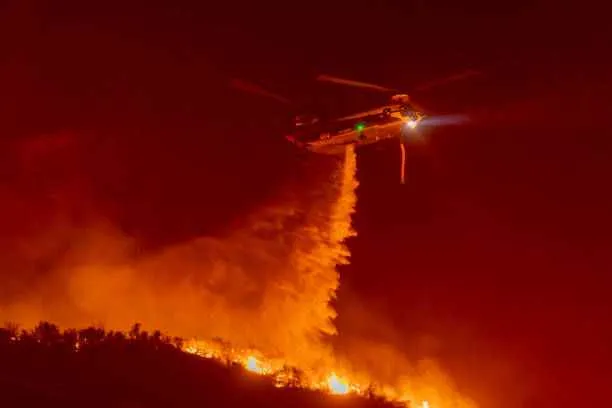Southern California wildfires fully contained after weeks of devastation
Firefighters achieve 100% containment of Eaton and Palisades fires, which left 29 dead and destroyed thousands of home.
 |
| A Boeing CH-47D Chinook helicopter releases up to 2,300 gallons of water over the Hughes Fire on January 22, 2025, in Castaic, California. Photo by David McNew/Getty Images |
By Hayu Andini and Adila Ghina
More than three weeks after the Eaton and Palisades fires tore through Southern California, state officials confirmed on Friday evening that firefighters had fully contained both blazes. This milestone means that the perimeters of the fires are now completely under control, marking the end of a deadly chapter that saw widespread destruction.
Evacuation orders had already been lifted in the affected areas, and the fires had not posed a major threat for over a week. However, the confirmation of full containment brings a sense of closure to communities that have endured unimaginable loss. The Eaton and Palisades fires killed at least 29 people, displaced thousands of residents, and razed entire neighborhoods.
Cal Fire, the state's firefighting agency, updated its reports on Friday night to reflect 100% containment of both wildfires.
Devastation left in the wake of the Eaton and Palisades fires
The Palisades fire wreaked havoc on coastal communities, destroying more than 6,800 structures and scorching 23,448 acres across the Pacific Palisades neighborhood of Los Angeles and Malibu. Meanwhile, the Eaton fire, which burned through the Altadena area in Los Angeles County, claimed over 9,400 structures and consumed 14,021 acres.
While the immediate danger has passed, the long-term impact of the fires remains severe. At least 14 people are still missing—two from the Palisades fire and 12 from the Eaton fire. Officials have warned that full recovery efforts, including rebuilding homes and infrastructure, could take years and cost hundreds of billions of dollars.
Beyond the financial toll, the fires have left lingering concerns about public health, particularly due to prolonged exposure to hazardous smoke and poor air quality. Many residents are also grappling with emotional trauma, as entire communities struggle to recover from the loss of homes, businesses, and loved ones.
Firefighters gain control amid challenging conditions
Bringing the wildfires under control was a monumental challenge for firefighters, as persistent Santa Ana winds repeatedly threatened to reignite flames and spread the destruction further. These powerful, dry winds exacerbated the fires, making suppression efforts more difficult.
However, after weeks of relentless firefighting, crews finally gained the upper hand. Light rain last weekend provided much-needed relief, helping to calm the fires, though it also triggered minor mudslides in some areas.
With the fires now contained, many residents of Altadena and the Pacific Palisades have begun returning to their communities, hoping to salvage any belongings that survived the inferno. This past week marked the first time that most Pacific Palisades residents could see the extent of the damage firsthand.
Rebuilding efforts begin as residents return home
The road to recovery will be long and arduous. Officials estimate that rebuilding could take years, as thousands of homes and businesses must be reconstructed from the ground up. For many residents, the process of rebuilding their lives began this week as Environmental Protection Agency (EPA) crews arrived to clear hazardous debris from the burned areas.
Local and state officials have vowed to provide resources and support to those affected. Kathryn Barger, chairwoman of the Los Angeles County Board of Supervisors, commended firefighters and emergency responders for their dedication throughout the crisis. In a statement, she emphasized the need to focus on rebuilding, recovery, and future preparedness.
"The Eaton fire has taught us all that we must remain vigilant and prepare for the unimaginable," Barger said.
Long-term impact and future wildfire concerns
While the containment of the Eaton and Palisades fires marks the end of an immediate crisis, experts warn that California remains vulnerable to future wildfires. Climate change, prolonged drought conditions, and strong winds create a dangerous combination that makes the state increasingly susceptible to catastrophic blazes.
Officials are urging communities to take wildfire preparedness seriously, investing in fire-resistant infrastructure, defensible spaces around homes, and improved emergency response strategies. Additionally, discussions around stricter building codes, forest management policies, and controlled burns have resurfaced as authorities seek to mitigate the risks of future wildfires.
Despite the devastation, the resilience of affected communities remains strong. Residents and officials alike are determined to rebuild and move forward, even as they acknowledge the challenges that lie ahead.
For now, the containment of the Eaton and Palisades fires offers some relief to Southern California, signaling an end to one of the region’s most destructive fire events in recent years. However, as the state enters another dry season, the battle against wildfires is far from over.
